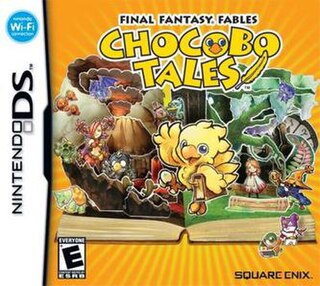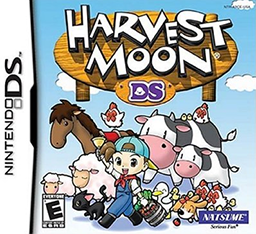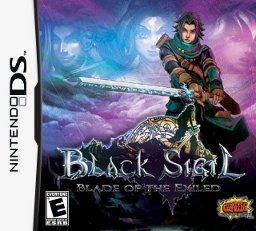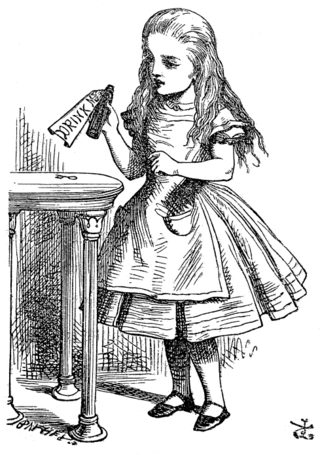
Super Princess Peach is a 2005 platform game developed by Tose and published by Nintendo for the Nintendo DS. It was released in Japan in October 2005 and worldwide the following year. Super Princess Peach is the first game to feature Princess Peach as the main protagonist on a dedicated video game console and the second overall after Princess Toadstool's Castle Run released in 1990 on the Nelsonic Game Watch.

Rune Factory: A Fantasy Harvest Moon is a simulation role-playing video game developed by Neverland and published by Marvelous Interactive Inc., Natsume Inc., and Rising Star Games for the Nintendo DS handheld video game console.

LostMagic is a real-time strategy role-playing video game developed by Taito for the Nintendo DS system. It supported the Nintendo Wi-Fi Connection.

The Looking Glass Wars is a series of three novels by Frank Beddor, heavily inspired by Lewis Carroll's 1865 novel Alice's Adventures in Wonderland and its 1871 sequel Through the Looking-Glass. The premise is that the two books written by Lewis Carroll are a distortion of the "true story".

Final Fantasy Fables: Chocobo Tales, released in Japan as Chocobo to Mahō no Ehon is a Nintendo DS adventure game developed by h.a.n.d. and published by Square Enix. It was released in Japan on December 14, 2006, in North America on April 3, 2007, and in the PAL region in May.

Luminous Arc is a tactical role-playing game developed by Imageepoch for the Nintendo DS, and the first in the Luminous Arc series. The game was released on February 8, 2007 in Japan, August 14, 2007 in North America, and October 18, 2007 in Australia by Atlus, and in Europe the following day by Rising Star Games.

Orcs & Elves is an adventure role-playing video game for the mobile phone and Nintendo DS. It was developed by id Software and Fountainhead Entertainment and published by EA Mobile and licensed by Nintendo for the DS version. It was released for mobile phones in May 2006 before being ported to the Nintendo DS in November 2007. The game is based on Doom RPG's engine and is id's first original intellectual property since Quake. The DS port of the game included graphical enhancements, such as 3D environments and camera cutscenes, along with improved character sprites, two new levels and the use of the touchscreen feature.

Harvest Moon DS, known in Japan as Bokujō Monogatari: Colobocle Station, is a farm simulation role-playing video game for the Nintendo DS, part of the Story of Seasons series. It was published and developed by Marvelous Interactive Inc., and released in Japan on March 17, 2005, and in North America on September 12, 2006. It is the first entry in the series without series creator Yasuhiro Wada heavily involved, though it borrows many assets from Harvest Moon: Friends of Mineral Town and Harvest Moon: A Wonderful Life, such as the graphical style from the former and setting of the latter.

Luminous Arc 2 is a tactical role-playing game developed by Imageepoch for the Nintendo DS, and published by Marvelous Entertainment in Japan on May 15, 2008, and by Atlus USA and Rising Star Games in North America and Europe respectively. It is the second game in the Luminous Arc series.

Black Sigil: Blade of the Exiled is a role-playing video game for the Nintendo DS developed by Studio Archcraft, a video game developer which is based in Montreal, Quebec, Canada. Black Sigil was published by Graffiti Entertainment on June 9, 2009. The game was originally planned for release on Nintendo's Game Boy Advance system, but Studio Archcraft made the decision to move the game to the Nintendo DS as by the time the game was nearing completion, the GBA market was starting to dry up. In the years leading up to its release, it went by the early title Project Exile.

The Wizard of Oz: Beyond the Yellow Brick Road, known in Japan as Riz-Zoawd, is a role-playing video game developed by Japanese developer Media.Vision for the Nintendo DS. The game is an adaptation of L. Frank Baum's 1900 novel The Wonderful Wizard of Oz, using its characters, locations and plot. The game was originally published in Japan by D3 Publisher on December 25, 2008. Xseed Games published the game in North America on September 29, 2009.

Nostalgia is a role-playing video game developed by Red Entertainment and Matrix Software for the Nintendo DS handheld system. Initially released in November 2008 for Japanese audiences by Tecmo, an English version of the game was released for North America by Ignition Entertainment in October 2009. The game's development was headed by producer Keisuke Kikuchi, with programming and three-dimensional graphics by Matrix Software, who had previously developed Square Enix's Nintendo DS versions of Final Fantasy III and IV.

Lego Harry Potter: Years 1–4 is a Lego-themed action-adventure video game developed by Traveller's Tales and published by Warner Bros. The game is based on the Lego Harry Potter toy line, and its storyline covers the first four books by J.K. Rowling and its film adaptations in the Harry Potter film series: Harry Potter and the Philosopher's Stone (2001), Harry Potter and the Chamber of Secrets (2002), Harry Potter and the Prisoner of Azkaban (2004), and Harry Potter and the Goblet of Fire (2005).

Rune Factory 3: A Fantasy Harvest Moon is a 2009 simulation role-playing video game developed by Neverland for the Nintendo DS. It was published in Japan by Marvelous Entertainment, in North America by Natsume Inc. in 2010, and in Europe by Rising Star Games in 2011. It is the fourth game in the Rune Factory series. A remaster, Rune Factory 3 Special, was released for the Nintendo Switch in Japan in March 2023, followed by a worldwide release for both Switch and Windows in September.

Alice in Wonderland is an action-adventure video game published by Disney Interactive Studios. Based on Tim Burton's 2010 film of the same name, it was released in the same week as the film for the Wii, Nintendo DS, Microsoft Windows and Zeebo, with the soundtrack being composed by video game music composer Richard Jacques. The Wii, DS, and PC versions were released on March 2, 2010. The DS game is completely different from the Wii and PC versions.

Ni no Kuni: Wrath of the White Witch is an action role-playing game, developed by Level-5. The game is a significantly enhanced version of Ni no Kuni: Dominion of the Dark Djinn, which originally released for the Nintendo DS in Japan in December 2010. It was released for the PlayStation 3 in Japan in November 2011, and published in Western regions by Namco Bandai Games in January 2013. It was also released for Nintendo Switch in September 2019. A remastered version was released for PlayStation 4 and Windows in September 2019, and for Xbox One and Xbox Series X/S in September 2022.

Ni no Kuni: Dominion of the Dark Djinn is a role-playing video game developed and published by Level-5. It was released in Japan for the Nintendo DS on December 9, 2010. Players control Oliver, a young boy who sets out on a journey to save his mother. The game is played from a third-person perspective and its world is navigated on foot or by boat. While players navigate Oliver throughout the game's world, other characters can be controlled during battles against enemies; during these battles, players use magic abilities and creatures known as "imajinn", which can be captured and tamed.

Alice, the main protagonist of Lewis Carroll's novels Alice's Adventures in Wonderland (1865) and Through the Looking-Glass (1871), has been adapted to several media.

Luminous Arc is a series of tactical role-playing video games originally developed by Imageepoch, prior to the company's bankruptcy. The series began with the 2007 release of Luminous Arc for the Nintendo DS, with its most recent game being the 2015 Japan-only release of Luminous Arc Infinity. The series also saw a spiritual successor in the 2015 Nintendo 3DS game Stella Glow.


















